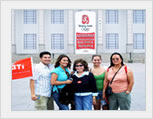
Chinese Traditional Furniture
 Representing the zenith of Chinese furniture, Ming furniture is treasured for its precious wood, comfortable design, simple decoration and superb craftsmanship. At the beginning of the Qing Dynasty (1644-1911), furniture followed Ming patterns and styles. During the reign of Emperors Kangxi, Yong Zheng, and Qian Long, Qing Furniture showed its own uniqueness with the absorption of western art. It was larger in size with grandeur and pageantry. Ming furniture: Ming furniture dates from the end of the Ming Dynasty, a transitional time in Chinese history. During the beginning and the middle of the Ming Dynasty, austerity was a government edict. Later, though the economy gained substantial growth, people had to remain low-keyed about their wealth to avoid
Representing the zenith of Chinese furniture, Ming furniture is treasured for its precious wood, comfortable design, simple decoration and superb craftsmanship. At the beginning of the Qing Dynasty (1644-1911), furniture followed Ming patterns and styles. During the reign of Emperors Kangxi, Yong Zheng, and Qian Long, Qing Furniture showed its own uniqueness with the absorption of western art. It was larger in size with grandeur and pageantry. Ming furniture: Ming furniture dates from the end of the Ming Dynasty, a transitional time in Chinese history. During the beginning and the middle of the Ming Dynasty, austerity was a government edict. Later, though the economy gained substantial growth, people had to remain low-keyed about their wealth to avoid
 high taxes. Considered the pinnacle of Chinese furniture, Ming furniture made use of precious wood while emphasizing comfort, simplicity and excellence in craft. Most Ming furniture dates to the latter part of the Ming Dynasty when the style changed to favor luxury and novelty. Adjustable beds made from bamboo were popular at this time due to the different resting positions available and the convenience of being able to use them in and out of doors. Qing Furniture: During the early Qing Dynasty the Ming style remained dominant, but later a heavily Western influenced style evolved. Qing furniture is characterized by extensive use of inlays in precious materials such as ivory, gemstones and bone rather than the carvings of previous work.. Colour painting and
high taxes. Considered the pinnacle of Chinese furniture, Ming furniture made use of precious wood while emphasizing comfort, simplicity and excellence in craft. Most Ming furniture dates to the latter part of the Ming Dynasty when the style changed to favor luxury and novelty. Adjustable beds made from bamboo were popular at this time due to the different resting positions available and the convenience of being able to use them in and out of doors. Qing Furniture: During the early Qing Dynasty the Ming style remained dominant, but later a heavily Western influenced style evolved. Qing furniture is characterized by extensive use of inlays in precious materials such as ivory, gemstones and bone rather than the carvings of previous work.. Colour painting and
 gilding also became highly popular. Engraving was a popular and important means of furniture decoration. The subjects range from auspicious character patterns, to geometric patterns and scenes in nature with animals, mountains and waters, flowers and grass. Color painting, especially gold painting, was widely used.These practices represented the fashion of displaying wealth in an ostentatious manner that had emerged in China at the time.Furniture-making centers were formed in Beijing, Shanxi, Guangzhou and Suzhou. In the Forbidden City in Beijing, the best craftsmen used the choicest wood to make Qing-styled furniture under the guidance of the Emperors.
gilding also became highly popular. Engraving was a popular and important means of furniture decoration. The subjects range from auspicious character patterns, to geometric patterns and scenes in nature with animals, mountains and waters, flowers and grass. Color painting, especially gold painting, was widely used.These practices represented the fashion of displaying wealth in an ostentatious manner that had emerged in China at the time.Furniture-making centers were formed in Beijing, Shanxi, Guangzhou and Suzhou. In the Forbidden City in Beijing, the best craftsmen used the choicest wood to make Qing-styled furniture under the guidance of the Emperors.
Your Question & Quick Answer*We welcome and appreciate your questions & reviews
User Comments
Booking Procedures | Terms & Conditions | Payment Methods | Links | Site Map | About Us | Contact Us | Travel Agent
Copyright 2008, All rights reserved.. itourbeijing.com ,china culture, china introduction
TEL: 86-10-85711972 (Universal) 1-888-288-9328 (North America) E-mail: contact@itourbeijng.com
Home | China Tours | Beijing Tours | Tibet Tours | China Travel | Beijing Travel | Shanghai Travel



